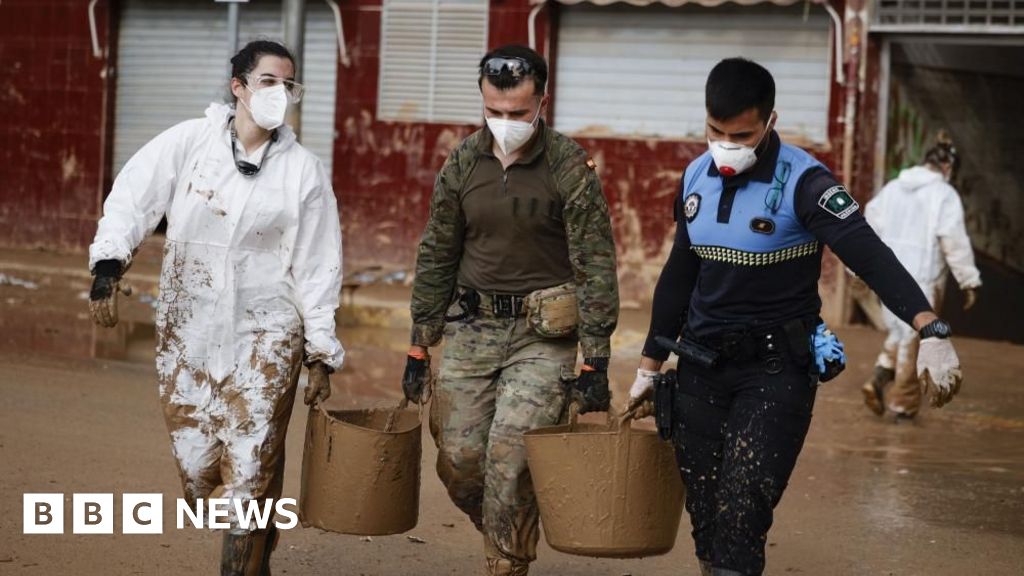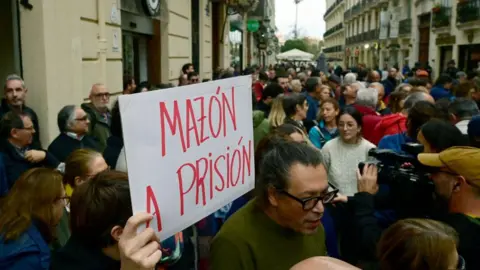
 EPA-EFE/REX/Shutterstock
EPA-EFE/REX/ShutterstockValencia’s under-fire leader Carlos Mazón has conceded mistakes were made on the day that floods overwhelmed his region but said it was down to two government agencies that people were not given enough warning.
More than 220 people lost their lives when areas of Spain were hit by floods on 29 October, and most of the fatalities were in Mazón’s eastern coastal region.
Valencia’s conservative leader ignored calls for his resignation during his first appearance before the regional parliament since the floods.
He has been widely criticised for spending much of the afternoon having lunch with a journalist rather than focusing on Valencia’s response to the rapidly developing crisis.
No alert was sent to residents in the region until 20:11 on the Tuesday, by which time the floods had already reached the congested V31 highway known as the Pista de Silla in the Valencia suburbs.
Mazón spoke at length in the regional parliament Les Corts on Friday, defending his handling of the disaster, and explaining that the text alert system had never been used before.
A police helicopter hovered above as dozens of protesters, held back by police from the building where Mazón was speaking, chanted angry calls for him to resign or face arrest.
 Getty Images
Getty Images“El President a Picassent,” they shouted, saying that the regional leader belonged in a local prison.
Some of the protesters held placards that read: “Our hands are stained with mud. Theirs are stained with blood.”
He pointed the finger at Spain’s Aemet weather agency as well as the independent Júcar authority that looks after the river basin and water resources.
Aemet had issued a red alert early on 29 October and extended it to the entire Valencia area, with the threat of “extreme” danger”. By mid afternoon it was warning of 150-180 mm of rainfall over 12-24 hours.
“I’m not going to deny mistakes,” he said, promising that he would not shirk his responsibilities, while explaining that not enough details had been provided.
“We did the best we could in the situation we were in, with the information available and with the resources we had, which was clearly not enough.”
 EPA-EFE/REX
EPA-EFE/REXSpain had not witnessed such a devastating natural disaster in recent history, he insisted and it was “as terrifying as it was unprecedented”. That explained why there was a widespread feeling that help was not coming or it was insufficient, he said, adding: : “I want to apologise to those who felt that way.”
“The mismanagement was abhorrent,” one young man told the BBC, adding that lives could have been saved if the disaster had been better handled: “He has declared he’s not willing to step down so we need to keep up the volume against him.”
On the outskirts of Valencia in the town of Paiporta, which was hit hardest by the flood, a sludge of mud is everywhere, blocking drains so that many residents cannot use their toilets and the air carries the smell of sewage.
Weary residents trudge through the streets as bulldozers try to scoop up the liquid mess. The army is still towing away wrecked cars which were tossed around in the floodwaters.
On Florida Street, people are busy at work trying to fix broken doors and clear out the mud.
“It’ll be months before it’s back to normal,” said father of two José Sánchez Maigallon, whose 43-year old neighbour was swept away by the torrent. “Everyone has messed up, from the local mayor to the regional president to the government in Madrid.”
Many here complain about the slow response of the authorities to help survivors.
“If it weren’t for the volunteers, we would have died of hunger,” added Maigallon. “They’re the ones bringing us food. And hope.”
Eventually Carlos Mazón sought to explain why he had not gone to the Operational Coordination Centre until 19:00 on the evening of the flood as the regional interior minister Salomé Pradas was already there.
Pradas herself has since conceded she was not aware of the ES-Alert text message system that was available to warn the local population of the flood risks.
Shortly after 20:00 on 29 October a first message was sent out warning of the imminent risk of a dam being breached.

